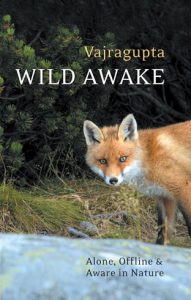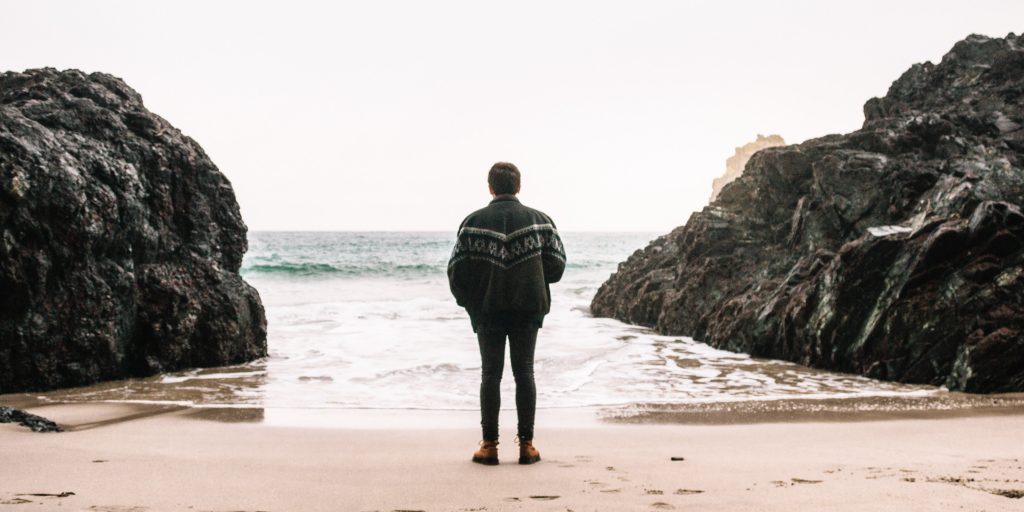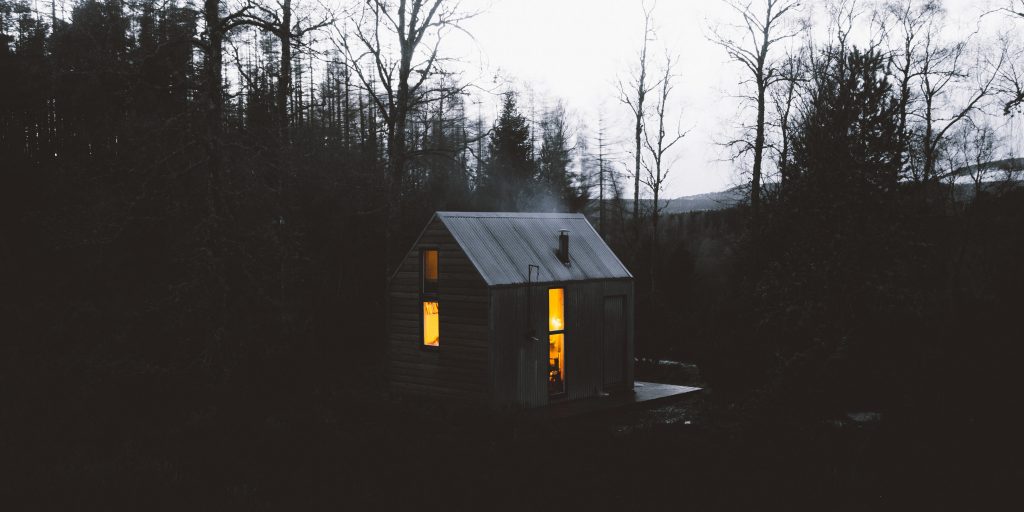Wild Awake: Alone, Offline, and Aware in Nature, by Vajragupta (Windhorse, 2018)
Review by Jim Champion
Vajragupta, the author of this rich and inspirational new book, went on his first solitary retreat over twenty-five years ago when he was in his early twenties. For two weeks he stayed alone and unconnected to other humans in a caravan in the corner of a field in the west of Wales and found it to be a life-changing experience. Nearly every year since he has made the time to get away from his normal socially-connected urban life and spend extended periods of time alone in nature, learning through experience about the fluidity of the boundaries between himself and his surroundings. In his own words, in the introduction to the book, he sums up what the book is about:
“I have discovered a love of solitude, silence and simplicity. This book tells the story of that discovery and why it still feels important.”
 The main body of the book comprises ten chapters: each chapter focuses mainly on a different solitary retreat undertaken by the author and these experiences are presented in chronological order, starting with his first solitary retreat in the caravan near the coast in west Wales. Following these chapters, there are two appendices, and the first of these – an A-to-Z guide to conducting your own solitary retreat – is substantial and could easily be expanded to form a short instructional book in its own right. The second, shorter appendix contains a pair of ritual texts for being alone and aware in nature, adapted by the author from a Triratna ritual and a Buddhist sutta. The book has no illustrations or photographs, apart from the cover photograph of an encounter with a fox, but this not a limitation as the descriptive prose is lucid enough to make actual pictures unnecessary.[1]
The main body of the book comprises ten chapters: each chapter focuses mainly on a different solitary retreat undertaken by the author and these experiences are presented in chronological order, starting with his first solitary retreat in the caravan near the coast in west Wales. Following these chapters, there are two appendices, and the first of these – an A-to-Z guide to conducting your own solitary retreat – is substantial and could easily be expanded to form a short instructional book in its own right. The second, shorter appendix contains a pair of ritual texts for being alone and aware in nature, adapted by the author from a Triratna ritual and a Buddhist sutta. The book has no illustrations or photographs, apart from the cover photograph of an encounter with a fox, but this not a limitation as the descriptive prose is lucid enough to make actual pictures unnecessary.[1]
Vajragupta’s stated intention for the book is to “inspire other people to undertake solitary retreats and also help them to see how being in nature can be a valuable part of the practice.” My own inclinations mean that I was sympathetic to this intention from the start, and thus I’m probably not a particularly impartial judge of the extent to which he has accomplished this goal. However, as a result of having read the book, I do feel more inspired to undertake solitary retreats, and I think I now understand better how being in nature can be a valuable part of the process. In my opinion, Vajragupta succeeds in presenting solitary retreats as realistic, achievable, worthwhile and perhaps even necessary in this ‘always-on’ era of smartphones and social media. Whatever your starting point in relation to this intention, this is clearly a book written by an author who loves what he is writing about, and it could be read simply for the joy of being taken along for the ride… take this representative paragraph from Chapter 2 as an example:
“The heady, warm, and woody aroma of pine resin hits the back of the nostrils in the hot of summer. Silence, and then a sudden, sharp crack and a pine cone expands and opens out in the heat. Sometimes there is a great roar of wind rising up the valley, like a huge rushing wave, flooding the trees with sound. It comes rolling upwards, surging through the woodland, and often you hear the noise in the distance long before you feel the warm air against your skin. There are snakes and iridescent lizards, gorgeous butterflies and flowers, scorpions and big spiders, wild boar, and, sometimes, wild cats and deer up on the hilltops. The whole valley is alive.”
The ten chapters of the book are largely descriptive and emotional, telling autobiographical anecdotes that refer to the author’s subjective experience and his reflections on the meaning and significance of those experiences. This is a book about one person’s spiritual maturation over several decades, of increasing self-awareness achieved through solitude and contemplation. It is not about book-learning, and the few instances of scientific ideas being brought in to explain some feature of nature or human psychology (although accurate) seem unnecessary. Vajragupta’s style is also very honest, without pretence: he does not attempt to portray his trials in the wild as a triumphant ‘Bear Grylls’-style survival situation – for example, on the occasions when he wanted to sleep outdoors he admits to finding it very uncomfortable and meant that he got very little rest, and when his cabin’s stove wouldn’t work during an exceptionally cold spell he now sees that it was his foolish youthfulness that stopped him from getting someone in to fix it right away.
 Through the autobiographical elements of the book, we learn that the author first came into contact with Buddhism whilst at university in the late 1980s and was given the name Vajragupta in 1994 when he was ordained into Triratna Buddhist Order. Since then he has worked in several key roles in the organisation, as well as writing three books with the word ‘Buddhist/Buddhism’ in the title, also published by Windhorse. As a consequence, his existing audience is most likely to be looking at life from a Buddhist perspective, particularly the flavour of Western Buddhism found within the Triratna organisation. However, in writing this book Vajragupta has been careful to assume that the reader does not necessarily have anything other than a general knowledge of Buddhism: he freely acknowledges that being the person he is means that it is inevitable that his analyses are framed in a Buddhist way, and he is careful to avoid unnecessary or unexplained use of Buddhist terminology in order to avoid alienating his potential audience.
Through the autobiographical elements of the book, we learn that the author first came into contact with Buddhism whilst at university in the late 1980s and was given the name Vajragupta in 1994 when he was ordained into Triratna Buddhist Order. Since then he has worked in several key roles in the organisation, as well as writing three books with the word ‘Buddhist/Buddhism’ in the title, also published by Windhorse. As a consequence, his existing audience is most likely to be looking at life from a Buddhist perspective, particularly the flavour of Western Buddhism found within the Triratna organisation. However, in writing this book Vajragupta has been careful to assume that the reader does not necessarily have anything other than a general knowledge of Buddhism: he freely acknowledges that being the person he is means that it is inevitable that his analyses are framed in a Buddhist way, and he is careful to avoid unnecessary or unexplained use of Buddhist terminology in order to avoid alienating his potential audience.
The gently Buddhist and contemplative nature of this book is what sets it apart from other autobiographical narratives about spending time alone in the ‘wild’ parts of the British Isles and Europe.[2] Although Vajragupta is not a big literary name outside of the Triratna organisation, the prose in his book compares favourably with the very best of this genre: Nature Cure by Richard Mabey, The Wild Places by Robert Macfarlane, The Living Mountain by Nan Shepherd and Waterlog by Roger Deakin. Perhaps the earliest example of a modern book addressing this subject is Henry David Thoreau’s Walden; or, Life in the Woods. Wild Awake fittingly starts with a quote from Walden, and Thoreau is quoted again a number of times elsewhere in the book. Vajragupta dedicates little of his book to re-presentation and discussion of other people’s experiences of solitary retreat (such as Thoreau’s period in his self-built cabin at Walden Pond) and this seems entirely fitting: the focus is very much on what he can say about his own experiences, not re-telling the experiences of others.
I’m hoping that the connection of this book to the practice of the Middle Way is obvious enough, but I feel I ought to make the connections explicit. Firstly, solitary retreats of the kind taken by Vajragupta are ideal occasions for implementation of individual practices that work towards the integration of desire. Robert M Ellis succinctly describes as this as “temporarily unifying energies to boost attention and creativity, and to avoid conflict.”[3] Examples of these practices are physical exercise, immersion in wilder environments, recreation (understood as a time taken out of our normal routines, especially “work”) and ethical avoidance of intoxicants and sexual activity. Blending all this with formal periods of meditation, whether it is meditation with a very tight focus of attention or a wide-open awareness, would form the main ‘programme’ of a solitary retreat, although it is obvious from the experiences described in the book that part of the process is discovering how flexible one needs to be in imposing a schedule on one’s retreat time.
Secondly, solitary retreats in rural environments will probably present the opportunity for integration of meaning, described by Robert as “broadening the symbols we understand and relate to, in ourselves and others.” Perhaps this is best expressed Vajragupta’s own words in the following paragraph taken from Chapter 1 of Wild Awake:
“We need images and metaphors with which to think and feel. The wild is full of images and metaphors, and so has a particular power to influence our thinking and feeling. Consciously or unconsciously, we weave threads and fabrics from the wild world into the warp and weft that is our interpreting and imagining. This is partly what poets and artists are doing, paying conscious attention to the correspondence of ‘inner’ and ‘outer’ experience, being open and alive to the possibility of resonance.”
Thirdly, it is quite likely that solitary retreats will help an individual with the integration of belief, described by Robert as “resolving conflicting assumptions to address conditions.” This certainly appears to have been the case for Vajragupta at the end of his first solitary retreat in the bargain caravan in the Llŷn Peninsula. He describes his feeling of returning home “a different person” after his two weeks of isolation, meditation and immersion in nature. The retreat conditions and his attitude towards them created the space where some of his assumptions and biases became more visible, and in seeing them he was then able to work to integrate some of the conflicts he had been experiencing. This aspect of practice was also obvious in his recollections about experimenting with his perception of and attitudes towards time. It was a very simple idea: on the first day of his month-long summer retreat in the north-western tip of Scotland he hid his watch away in the bottom of a drawer, and it led to the following realisations:
“Sometimes something would click into place; I would be flowing along with time, I could let go into the unfolding moment, rather than being in my usual mode of tussling with time. To flow with time is to forget time. Living in the land of the midnight sun accentuated that sense of timelessness.”
The above quote hopefully illustrates that reading about an experience is not the same as having that experience. Although the author has done an excellent job of creatively expressing experiences and realisations that are sometimes on the verge of being ineffable, simply reading this book is not going to integrate desire and belief for the reader – for that the reader will probably benefit from making their own solitary retreats into nature, and the A-to-Z guide in the book’s appendix is a good place to start.
Vajragupta acknowledges his limitations in being able to recommend a particular approach to solitary retreats, as one’s experience when undertaking such a venture is going to be very strongly influenced by one’s own temperament and conditioning. As I’ve already said, he also acknowledges that he can only write from a Buddhist perspective, but has taken care to try and avoid alienating the reader who does not move in those circles. To some extent this brings up the biggest challenge for Wild Awake: it is going to be difficult – through no fault of its own – for it to break out of the Triratna Buddhist world and to reach a wider readership. I sincerely hope this review will help with that, as this book deserves as wide an audience as possible.
Notes
- My review copy of Wild Awake was the e-book version (ISBN: 978-1-911407-19-5) supplied by Giulietta Spudich at Windhorse Publications in Cambridge, and I read it using the kindle app on an iPad. I have not seen the paperback version of the book (ISBN: 978-1-911407-18-8) so I cannot comment on its layout, typography and so on. Note that I have a very keen eye for typographical errors, and I found none at all in the e-book… good editing by Windhorse!
- Please note that I, and Vajragupta, grew up in the quiet and largely peril-free suburbs of England, the largest of the countries in the densely-populated island of Britain. Our concept of ‘wild’ might be your idea of ‘mild’ if you’re from somewhere else. Bear in mind that I’m writing this at home on a day when, following a very light overnight snowfall, the news will be of ‘traffic chaos’. It only takes a little wildness to take us out of our comfort zone here in the south of England.
- Robert M Ellis is the founder and chair of the Middle Way Society. He is the author of a number of books on the theory and practice of Middle Way Philosophy, and his summary of The Threefold Practice in Middle Way Philosophy is linked here.
Suggested further reading
- Roger Deakin, Waterlog (Vintage, 1999)
- Richard Mabey, Nature Cure (Chatto & Windus, 2005)
- Robert Macfarlane, The Wild Places (Granta, 2008)
- Nan Shepherd, The Living Mountain (Canongate, 1977)
- Henry David Thoreau, Walden; or, Life in the Woods (Ticknor & Fields, 1854)
Picture credits
- Cover of Wild Awake from Windhorse Publications
- Portrait photograph of Vajragupta from Windhorse Publications
- Photograph of a figure on a Cornish beach by Matt Cannon on Unsplash
- Photograph of a cabin in Scotland at dusk by Andrew Ridley on Unsplash



If you want to find out more, please follow this link to the book release blog post on the Windhorse publications website.
https://www.windhorsepublications.com/just-wild-awake-alone-offline-aware-nature/
From there you can purchase the book online, find out about dates on the UK book tour and also listen to or read an interview with Vajragupta about Wild Awake.
Thank you for your thoughtful and inspired review. We are happy our book’s prose stands shoulder-to-shoulder with The Wild Places, Waterlog and other lovely writing. It’s good to hear how inspiring it is of going into nature on one’s own. As a small, independent publisher, we appreciate you reviewing our book.
https://www.windhorsepublications.com/product/wild-awake-alone-offline-aware-nature-paperback/